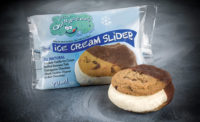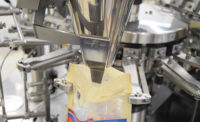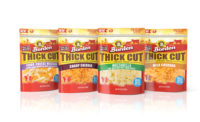It’s no surprise we’re seeing more flexible packaging in the dairy case. Its many positive attributes make a persuasive argument in favor of the format.
Flexible packaging can offer barrier properties, good machinability for efficient production and quality graphics.
“High-end flexographic printing possibilities … are one reason why dairies adopt flexible packaging,” said Rebecca Casey, vice president, marketing and consumer market development for TC Transcontinental Packaging, a Montreal-based supplier of rollstock, bags and pouches, coextruded films, shrink films and coatings.
High-resolution printing and strong colors grab attention, enhance brand identity and maximize shelf presence. For additional shelf impact, flexible packaging can be formed into unique shapes. However, the most compelling features spurring use of flexible packaging are its sustainability benefits.
“The flexible format makes it easy to empty the package with a minimum of product waste, and it gets flat as an envelope when empty,” explained Anna Annerås, director marketing for Ecolean Group, a Sweden-based supplier of lightweight packaging and filling machines.
Casey concurred.
“Flexible packaging offers a number of sustainability benefits throughout its entire lifecycle, including material/resource efficiency, light weight/source reduction, transportation benefits … shelf-life extension, reduced materials to landfill, high product-to-package ratio and beneficial life cycle metrics,” she said.
One dairy producer that is increasing its use of flexible packaging is Chobani LCC. The Norwich, N.Y.-based company recently launched Chobani Savor squeezable yogurt in an inverted resealable pouch, Chobani Gimmies yogurt in tubular packs and pouches, and 5- and 17-pound foodservice products in bags. Flexible packaging also was chosen as the secondary packaging for the Gimmies yogurt tubes.
“This shift [to flexible packaging] reflects Chobani’s desire to meet consumer behaviors with packaging that makes sense for specific needs,” said Niel Sandfort, vice president of product management and innovation at Chobani.
He predicts flexible packaging will gradually become a larger part of the Chobani portfolio.
The Gimmies line encourages consumption of yogurt throughout the day. The tubes are shorter than most competing options and fit better in kids’ lunchboxes.
“We opted for flexible secondary packaging for Gimmies tubes to allow for these tubes to be stored … in the cheese drawer, a home often occupied by string cheese and other healthy snacks,” Sandfort said. “The flexible secondary packaging setup generates efficiencies throughout our supply chain and significantly improves efficiency on the shelf for our retail partners.”
Adopting the flexible primary packaging was relatively simple since Chobani already had lines filling yogurt into tubes. New equipment was installed for the flexible secondary package, which replaces paperboard cartons used previously.
A patent-pending inverted squeezable pouch encourages use of Chobani Savor yogurt as an ingredient, topping or condiment.
“We are the first yogurt maker to package Greek yogurt in this manner and position it as a healthier alternative to sour cream,” Sandfort noted. “We love to think about packaging as a tool to cue usage occasion, especially as it relates to getting yogurt to be seen as a staple ingredient.”
For its part, New Zealand’s Tatua Dairy is introducing long-shelf-life premium dairy products for the foodservice industry in 1-liter Ecolean Air Aseptic pouches. Sold in Oceania and exported to many countries in the Asia-Pacific region, the product is ideal for foodservice use, with a tear-off, easy-open feature and an air-filled handle that simplifies handling and pouring.
“In Europe, products like mozzarella balls have even made their way into the pouch,” said Julian Stauffer, chief operating officer at PTI/Waldner North America, Tuckahoe, N.Y., which developed a rotary pouch-filling machine for this application.
Addressing trends
Flexible packaging also addresses trends in the dairy industry, including the rising interest in on-the-go consumption, single servings, smaller portion sizes for meal kits, drinkable yogurts and smoothies, and squeezable and sippable products for kids.
“With the on-the-go lifestyle, we are seeing a large growth in snacking cheeses,” Casey reported. “Consumers are more and more looking to snack quickly and healthy without sacrificing quality.”
Easy-open and resealable pouches and tubes make it easier to eat on the go and control portions. Consumers also want to see the product inside the package.
“Transparent packages are showing strong growth in the dairy segment for both chilled and ambient distribution,” Annerås said.
Another trend is a shift from pillow pouches to stand-up pouches. The stand-up format is often equipped with a spout, offers more facings in the dairy case, is convenient for consumers to store and represents a source reduction, which provides benefits across the supply chain.
The stand-up pouch is particularly popular in the European dairy industry, where it is replacing both pillow pouches and rigid packages. According to Annerås, the key drivers for the shift to stand-up pouches include its compatibility with the smaller pack sizes used for products consumed on the go and its ability to provide shelf differentiation, convenience and sustainability benefits.
According to Cheer Pack N.A., a West Bridgewater, Mass.-headquartered supplier of transparent CheerClear spouted pouches, custom-shaped CheerContours pouches and CheerPlus StandOut inverted pouches, spouted pouches deliver convenience (no spoon needed), portability and the best product-to-package ratio (35:1 compared to 1:1 with glass).
“This ratio efficiency produces not only a tangible financial transportation benefit — one truckload of flat pouches equates to the same number of glass jars in 26 truckloads — but also reduces greenhouse gas emissions by up to 93% versus other packaging formats,” said Al Madonna, director of marketing at Cheer Pack, citing a study by the Flexible Packaging Association.
Based on these benefits, consumers are voting with their wallets. According to Chicago-based market research firm IRI, sales of refrigerated yogurt in flexible pouches soared 72% between 2015 and 2017.
For spouted pouch filling, Waldner-designed fillers lower the fill valves into the spout and seal it. This avoids any potential product contamination on the exterior of the spout and protects product quality and shelf life.
There’s also growing interest in inverted pouches such as the designs used for Chobani Savor yogurt and Daisy sour cream.
“These are breakthrough packages re-inventing a mature market [by] adding a point of differentiation and consumer convenience,” said Dennis Calamusa, president and CEO at AlliedFlex Technologies Inc., a Sarasota, Fla.-based supplier of form-fill-seal and fill-seal equipment, including higher speed machinery for packaging shredded cheese in zipper-equipped stand-up pouches.
“Consumers are paying a premium for the convenience which the package brings to dispensing the product,” he said.
Calamusa predicts we’ll see more of the stand-up pouch format.
“Many companies have been challenged to stimulate flat sales of mature products, and packaging has shown to be an excellent tool to add excitement,” he said.
Cheer Pack’s recently launched CheerPlus StandOut inverted pouch addresses the need for a multi-serve package (e.g., 14 ounces of yogurt or sour cream). More sustainable than rigid plastic or glass bottles, it enables essentially 100% dispensing, eliminating residual product and food waste.
“With its more efficient packaging design, StandOut drives 5.5% greater return-on-investment sales dollars for a retailer per square shelf inch versus other players’ similar packaging formats,” Madonna explained.
Flexible packaging innovations
Flexible packaging innovations include both materials and equipment. On the materials side, Flair Flexible Packaging Corp., Appleton, Wis., introduced platinum nine-layer coextruded film, which combines an economical price point with superior hot tack properties for faster production speeds.
To address sustainability demands, Flair Flexible Packaging’s ENVi pouches, which are available in both high and standard barriers to oxygen, are approved for recycling via store drop-off programs through the Sustainable Packaging Coalition’s How2Recycle program. The proprietary multilayer film offers window clarity, superior print quality and protection against both oxygen and water vapor transmission.
Easy-opening convenience is offered by TC Transcontinental Packaging with its LaserTear scoring technology.
“We can provide the industry with both machine and cross-directional laser scoring and perforating technology, ensuring customers can reliably open the product with ease and consistency,” Casey said. “Our state-of-the-art scoring equipment enables calibration at specific intensities and frequencies and facilitates package designs that keep the product safer, fresher and longer.”
Other offerings from TC Transcontinental include MatteFX printing for artisanal cheeses and Nextrus vacuum shrink bags. Produced using proprietary sealant and extrusion technology, the bags contain no polyvinylidene chloride, offer exceptional clarity and high-gloss finish, and can be printed in up to 10 colors on both sides.
For cheese, premium brands are migrating to modified-atmosphere packaging with easy-open features or vacuum skin packaging to evoke an artisanal appearance. The Multivac R535 horizontal thermoform-fill-seal machine, equipped with specialized cutting, folding and integrated labeling, produces a flexible modified-atmosphere package with folded and labeled flaps, which provide an envelope-like easy-opening feature.
“This packaging concept is becoming popular across Europe, appealing to consumers with its ease of use and unique look,” said Drew Lericos, marketing director at Multivac, with U.S. headquarters in Kansas City, Mo.
Multivac also offers FormShrink technology, which wraps cheese blocks and wedges in film that conforms to the shape of the product. Available with various opening features, the vacuum skin packaging is produced on Multivac thermoforming equipment. Thermoforming reportedly results in higher rates and lower total cost of ownership than traditional vacuum bags handled on manual chamber machines or more automated rotary vacuum chamber machines.
Looking forward
The role of flexible packaging will continue to expand in the dairy industry.
“As consumers continue to embrace convenience as a result of their ‘on-the-go’ lifestyles, we will see more and more products introduced which only flexible packaging can provide with cost-effective results,” Calamusa said, “including superior product protection, freshness, increased shelf life and convenience.”
Sustainability also remains a strong driving force in favor of flexible packaging.
“That means creating a circular economy where all the players from sourcing, manufacturing and end-of-life management are involved and accountable to create the perfect sustainable packaging,” Casey said.
Dairy producers will continue to focus on sourcing more environmentally friendly substrates, and suppliers are working to meet this demand.
“Cheer Pack N.A. is actively working on developing and launching a recycle-ready spouted pouch,” Madonna noted.
Lericos foresees the introduction of paperboard-laminated flexible packages.
“[This structure] will enable the use of thinner plastics and improve … recyclability … while continuing to protect the product quality,” he said. “Thinner materials obviously lower the cost of the package, as well as offer a more sustainable option.”
Trevor Lauber, business development representative at Flair Flexible Packaging Corp. added that finding and using a structure easy for consumers to recycle will help reduce flexible film waste that ends up in landfills.










